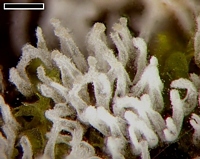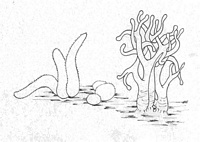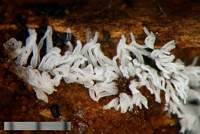|
 Ceratiomyxa fruticulosa Ceratiomyxa fruticulosa
SynonymsCeratium fuscum
Ceratium hydnoideum
Ceratium roseum
Tremella hydnoidea
Ceratiomyxa mucida
Byssus fruticulosa
Isaria mucida
Famintzinia fruticulosa
BiostatusPresent in region - Indigenous. Non endemic
Images (click to enlarge)
Caption: scale=0.5mm
Owner: J.A. Cooper | 
Caption: Fruiting bodies of Ceratiomyxa fruticulosa, which can consist of erect, simple columns (on the left) or more complex branched structures (on the right). The latter are about 5 mm tall.
Owner: S.L. Stephenson | 
Owner: J.A. Cooper |
Article: Stephenson, S.L. (2003). Myxomycetes of New Zealand. Fungi of New Zealand. Ngā Harore o Aotearoa 3: xiv + 238 p. Hong Kong: Fungal Diversity Press.
Description: Fruiting body unlike that of other myxomycetes, typically consisting of a series of erect, simple or branched columns but sometimes taking the form of a poroid or effused crust, usually white but sometimes pink or pale yellow to yellowish green, often 10 cm or more in extent, with the individual columns up to 10 mm high. Spores attached individually by threadlike stalks, white in mass, hyaline by transmitted light, smooth, typically somewhat variable in size and shape, mostly ovoid or elliptical but sometimes globose, 6–7 x 10–13 µm in diameter. Plasmodium watery and translucent, colourless or occasionally pale yellow (rarely somewhat pink, very pale orange, or light green).
Distribution: Apparently cosmopolitan (Martin & Alexopoulos 1969), but uncommon or absent at high latitudes and high elevations where woody substrates are lacking (Stephenson et al. 2000). First reported (as Ceratium hydnoides) from New Zealand by Cooke (1879), based on specimens collected in South Canterbury/Dunedin. Cooke also listed Ceratium fuscum and C. roseum, both of which were described as species new to science, in the same publication. Both are now regarded as nothing more than morphological variants of Ceratiomyxa fruticulosa and thus have been reduced to synonyms of the latter species. Ceratiomyxa fruticulosa known from Auckland, Coromandel, Bay of Plenty, Taranaki, Taupo, Wellington, Gisborne, Nelson, Buller, Westland, Fiordland, Otago Lakes, Southland, Stewart Island, Auckland Islands, and Campbell Island, but the species undoubtedly occurs in every part of New Zealand.
Notes: This is one of the most distinctive, abundant, and widespread myxomycetes in the forests of New Zealand. During the summer months, after a period of rainy weather, it can be found on all types of coarse woody debris. Lado (2001) indicated that the correct name for this species is Famintzinia fruticulosa, since the generic name Famintzinia antedates Ceratiomyxa and thus has priority over it. However, Ceratiomyxa is retained in the present work because this name is still the one used in other reference works currently available for the myxomycetes.
Article: Cooke, M.C. (1879). New Zealand fungi. Grevillea 8(46): 54-68.
Notes: More compact than C. roseum, retaining a somewhat ferruginous colour when dry.
Article: Cooke, M.C. (1879). New Zealand fungi. Grevillea 8(46): 54-68.
Notes: Although colourless when dried, the drawing which accompanied it gives distinctly the
form, and bright rose colour. It nevertheless requires better knowledge of its life-history
before its affinities become certain.
|